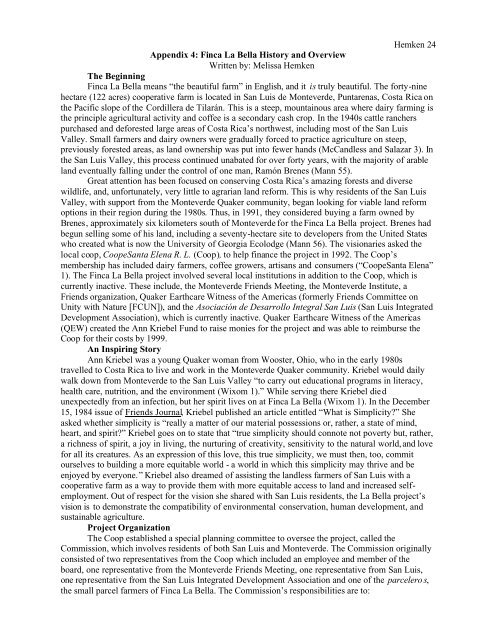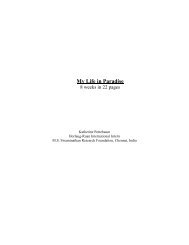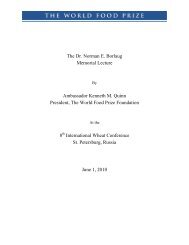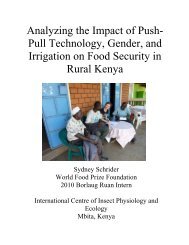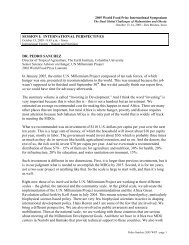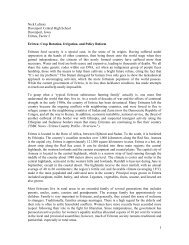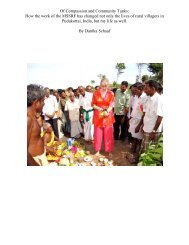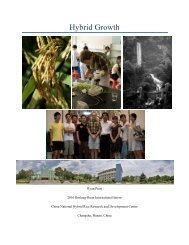A Green Mountain with a Valley Just Right - The World Food Prize
A Green Mountain with a Valley Just Right - The World Food Prize
A Green Mountain with a Valley Just Right - The World Food Prize
You also want an ePaper? Increase the reach of your titles
YUMPU automatically turns print PDFs into web optimized ePapers that Google loves.
Hemken 24Appendix 4: Finca La Bella History and OverviewWritten by: Melissa Hemken<strong>The</strong> BeginningFinca La Bella means “the beautiful farm” in English, and it is truly beautiful. <strong>The</strong> forty-ninehectare (122 acres) cooperative farm is located in San Luis de Monteverde, Puntarenas, Costa Rica onthe Pacific slope of the Cordillera de Tilarán. This is a steep, mountainous area where dairy farming isthe principle agricultural activity and coffee is a secondary cash crop. In the 1940s cattle rancherspurchased and deforested large areas of Costa Rica’s northwest, including most of the San Luis<strong>Valley</strong>. Small farmers and dairy owners were gradually forced to practice agriculture on steep,previously forested areas, as land ownership was put into fewer hands (McCandless and Salazar 3). Inthe San Luis <strong>Valley</strong>, this process continued unabated for over forty years, <strong>with</strong> the majority of arableland eventually falling under the control of one man, Ramón Brenes (Mann 55).Great attention has been focused on conserving Costa Rica’s amazing forests and diversewildlife, and, unfortunately, very little to agrarian land reform. This is why residents of the San Luis<strong>Valley</strong>, <strong>with</strong> support from the Monteverde Quaker community, began looking for viable land reformoptions in their region during the 1980s. Thus, in 1991, they considered buying a farm owned byBrenes, approximately six kilometers south of Monteverde for the Finca La Bella project. Brenes hadbegun selling some of his land, including a seventy-hectare site to developers from the United Stateswho created what is now the University of Georgia Ecolodge (Mann 56). <strong>The</strong> visionaries asked thelocal coop, CoopeSanta Elena R. L. (Coop), to help finance the project in 1992. <strong>The</strong> Coop’smembership has included dairy farmers, coffee growers, artisans and consumers (“CoopeSanta Elena”1). <strong>The</strong> Finca La Bella project involved several local institutions in addition to the Coop, which iscurrently inactive. <strong>The</strong>se include, the Monteverde Friends Meeting, the Monteverde Institute, aFriends organization, Quaker Earthcare Witness of the Americas (formerly Friends Committee onUnity <strong>with</strong> Nature [FCUN]), and the Asociación de Desarrollo Integral San Luis (San Luis IntegratedDevelopment Association), which is currently inactive. Quaker Earthcare Witness of the Americas(QEW) created the Ann Kriebel Fund to raise monies for the project and was able to reimburse theCoop for their costs by 1999.An Inspiring StoryAnn Kriebel was a young Quaker woman from Wooster, Ohio, who in the early 1980stravelled to Costa Rica to live and work in the Monteverde Quaker community. Kriebel would dailywalk down from Monteverde to the San Luis <strong>Valley</strong> “to carry out educational programs in literacy,health care, nutrition, and the environment (Wixom 1).” While serving there Kriebel diedunexpectedly from an infection, but her spirit lives on at Finca La Bella (Wixom 1). In the December15, 1984 issue of Friends Journal, Kriebel published an article entitled “What is Simplicity?” Sheasked whether simplicity is “really a matter of our material possessions or, rather, a state of mind,heart, and spirit?” Kriebel goes on to state that “true simplicity should connote not poverty but, rather,a richness of spirit, a joy in living, the nurturing of creativity, sensitivity to the natural world, and lovefor all its creatures. As an expression of this love, this true simplicity, we must then, too, commitourselves to building a more equitable world - a world in which this simplicity may thrive and beenjoyed by everyone.” Kriebel also dreamed of assisting the landless farmers of San Luis <strong>with</strong> acooperative farm as a way to provide them <strong>with</strong> more equitable access to land and increased selfemployment.Out of respect for the vision she shared <strong>with</strong> San Luis residents, the La Bella project’svision is to demonstrate the compatibility of environmental conservation, human development, andsustainable agriculture.Project Organization<strong>The</strong> Coop established a special planning committee to oversee the project, called theCommission, which involves residents of both San Luis and Monteverde. <strong>The</strong> Commission originallyconsisted of two representatives from the Coop which included an employee and member of theboard, one representative from the Monteverde Friends Meeting, one representative from San Luis,one representative from the San Luis Integrated Development Association and one of the parcelero s,the small parcel farmers of Finca La Bella. <strong>The</strong> Commission’s responsibilities are to:


